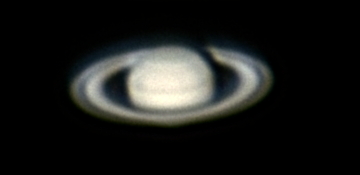High Magnification Planet Imaging Tests, Mars-Moon Conjunction
Posted: 3 October 2020
|
Open: Friday, 2 October 2020, 1806 MST Temperature: 86°F |
Session: 1529 Conditions: Clear |
Equipment:
12" f/8 LX600 w/StarLock
2" 24mm UWA eyepiece
2" 2X Powermate
1.25" 3X TeleXtender
2" 4X Powermate
Camera:
D850 DSLR
1808 MST: sunset.
1811 MST: LX600 ON, StarLock OFF, High Precision OFF.
Viewed Jupiter and 4 moons, 102X. Then Saturn, 102X
Prepared the D850 DSLR for planet imaging, then relaxed on the observatory bench for a short while to let the sky get a little darker.
1846 MST: back in the observatory. Began doing high magnification imaging tests of Jupiter and Saturn with the D850 DSLR. I did still and video recordings (1080p, 60fps, 2 minutes) at various exposure settings. The best results were stacked images from the videos.
Jupiter, 2X Powermate + 3X TeleXender, 7260 frames, 1/60sec, ISO 3200

Jupiter, 4X Powermate + 2X Powermate, 7264 frames, 1/60sec, ISO 5000

Saturn, 2X Powermate + 3X TeleXender, 7263 frames, 1/60sec, ISO 12800

Saturn, 4X Powermate + 2X Powermate, 7227 frames, 1/60sec, ISO 25600

1937 MST: Mars rose over the hill to the east, followed by the waning gibbous Moon at 1940 MST. I began waiting for both to rise higher in the sky.
1958 MST: began imaging the Mars-Jupiter conjunction (1°22' separation). This cropped image was taken with the D850 DSLR (f/8/ 1/400sec, ISO 200, FL 600mm). Mars is in the upper left corner. The inset on the right shows the magnified view of Mars from the full size image.

2009 MST: viewed the Mars-Moon conjunction, 12x50 binoculars. Pretty sight.
I then viewed Moon, then Mars at the 12" telescope, 102X.
Viewed the Moon then Mars, 49X. Viewed Mars, 406X. Fairly nice view but Mars was too low for good viewing.
2020 MST: began relaxing on the bench to wait for Mars to rise higher. Enjoyed being under the night sky.
2130 MST: back at the telescope. Viewed Mars, 406X. Mounted the D850 on the telescope for more high magnification test imaging using stills and video recordings (1080p, 60fps, 2 minutes) at various exposure settings. As with Jupiter and Saturn, the best images were from stacked video frames.
Mars, 2X Powermate + 3X TeleXender, 7266 frames, 1/60sec, ISO 1600

Mars, 4X Powermate + 2X Powermate, 7254 frames, 1/250sec, ISO 5000

The North Polar Hood, South Polar Ice Cap, some clouds on the right limb, and nice dark areas on the planet are visible, especially in the 4X Powermate + 2X Powermate image.
2221 MST: ended imaging tests.
Viewed Mars, 406X.
2230 MST: LX600 OFF.
|
Close: Friday, 2 October 2020, 2241 MST Temperature: 70°F |
Session Length: 4h 35m Conditions: Clear |
Comments are welcome using Email. Twitter users can use the button below to tweet this report to their followers. Thanks.
Cassiopeia Observatory Home Page
Copyright ©2020 Michael L. Weasner / mweasner@me.com
URL = http://www.weasner.com/co/Reports/2020/10/03/index.html
